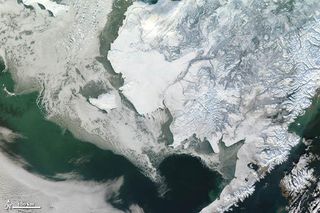
Clear Skies Over Alaska

The clouds that normally shroud much of the Arctic cleared on Jan. 12, 2011, to unveil a snow-bound Alaska.
From an altitude of 438 miles (705 kilometers), where NASA's Aqua satellite resides in orbit, snow can reveal subtle details in the color and terrain of a landscape. In this image, Alaska's rugged topography and main ecosystems are highlighted.
Inland, the vast boreal forest is dark, colored by evergreen trees that shed snow from their tall, conical forms. The treeless tundra, on the other hand, is bright white. The low shrubs and mosses on the tundra along the coast and above the tree line in the mountains do not break through the snow, so the landscape is an unrelieved white except for the slender rivers winding across the landscape.
Winter white extends to the ocean as land-bound ice swells the coast. The shadow of the summer coastline, where land meets sea ice, traces a faint outline a hint of gray between stark white sea ice and equally white coastal tundra.
A brown and green channel of semi-open water separates the continent from the ice-choked Bering Sea . Moving away from land, ice creeps across the open sea in wisps and curls that resemble foamy froth.
Beyond the clutches of ice, the Bering Sea shows signs of turbulence and the dark waters swirl with vibrant green. Such color often points to phytoplankton, but this burst of color could also be sediment brought to the surface by powerful waves spawned by winter storms.
Sign up for the Live Science daily newsletter now
Get the world’s most fascinating discoveries delivered straight to your inbox.

